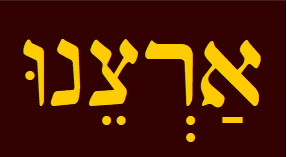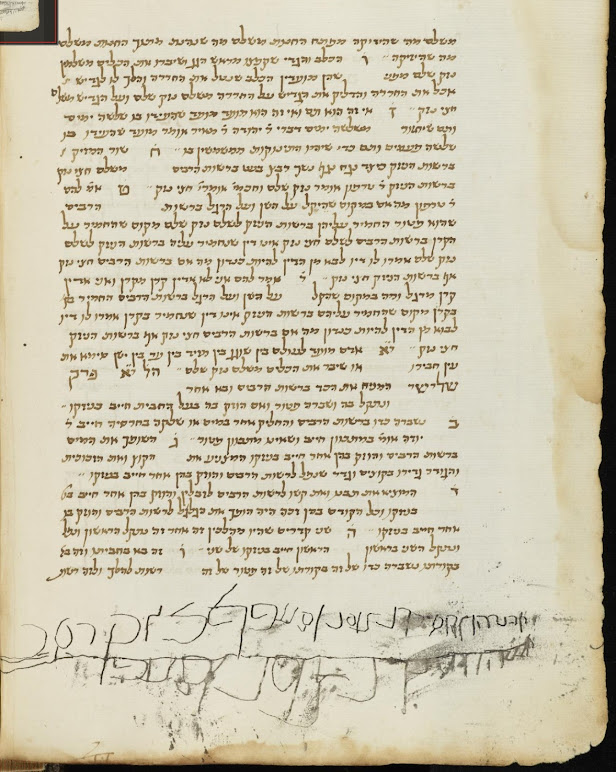Showing posts with label Mishna. Show all posts
Showing posts with label Mishna. Show all posts
Thursday, March 30, 2023
 Thursday, March 30, 2023
Thursday, March 30, 2023 Elder of Ziyon
Elder of Ziyon Artzeinu, Hebrew, indigenous, Jewish prayer, Land of Israel, Mishna, our land, Psalms
Artzeinu, Hebrew, indigenous, Jewish prayer, Land of Israel, Mishna, our land, Psalms
Anti-Zionists like to claim that Jews have no right to Israel because they were absent from the land for so long, and therefore the rights have been extinguished over time.
The proof they are wrong, of course, is that Jews have always maintained our emotional attachment to the Land of Israel. Our absence from the land was forced upon us and not a choice. The most famous example is the phrase at the end of the Passover seder and at the end of Yom Kippur services, "Next Year in Jerusalem!"
And, of course, every day, Jews in their prayers ask God to restore us to the Land and rebuild the Temple.
However, that argument has a flaw. Those examples may prove only that Jews want the Messiah to arrive and then return to the land of our forefathers. But what abut the ongoing attachment to the land in the two thousand years of diaspora? How can the ties that each Jew has in each generation, not a theoretical future, be proven?
This attachment can be proven by a single Hebrew word, and that word is אַרְצֵֽנו.
"Artzeinu" means "our land. " It is used about a half dozen times in the Hebrew scriptures, but the use of the word multiplied after our exile began.
Almost invariably, the term "our land" in Jewish literature refers to the Land of Israel - and no other.
The Sefaria database of Jewish texts finds אַרְצֵֽנו is used scores of times in the Talmud, 145 times in the Medrash, dozens of times in Jewish liturgy and hundreds of times in Jewish legal texts. And the passage of time does not lessen the use of the word - on the contrary, it can be found in texts written in the 19th and 20th centuries as well, by scholars who were not Zionist at the time.
From Psalms: "The LORD also bestows His bounty; our land yields its produce."
To the Mishna: "One who sees a place from which idolatry was eradicated recites: Blessed…Who eradicated idolatry from our land."
To the Talmud:"Rav Ḥisda said to Rav Yitzḥak: This balsam oil, what blessing does one recite over it? Rav Yitzḥak said to him, this is what Rav Yehuda said: One recites: Who creates the oil of our land, as balsam only grew in Eretz Yisrael, in the Jordan valley."
To the Grace After Meals: "May the All-merciful break the yoke from off our neck, and lead us upright to our land."
To Maimonides: "It is forbidden to sell [non-Jews] homes and fields in Eretz Yisrael....It is permitted to sell them houses and fields in the Diaspora, because it is not our land."
To the Chofetz Chaim (early 20th century) saying that the sin of loshon hora, speaking negatively about others, is "so severe as to have caused us to be exiled from our land!"
And on and on, through commentaries, works of philosophy, and responsa literature.
There is no need to qualify the term to say "our land of Israel" or to give it any other name. The phrase "our land" needs no explanation to the Jewish people that read these texts. Everyone knows what "artzeinu" refers to. No one would think for a second that "our land" refers to Babylonia or Egypt or Poland or Lithuania or anywhere else the authors and writers lived.
No matter how far we moved away, how much we were dispersed, how bleak the future looked, Jews always knew that there was a land - and only one land - that is ours.
And this one word, used in so many ways by Jews throughout history but always with the same meaning, proves it.
Thursday, March 23, 2023
The University of Cambridge has a small but impressive collection of digitized Hebrew manuscripts. I mentioned their 15th century complete Mishna yesterday.
Some of the creatures drawn remind me of Dr. Seuss. But as the page above shows, the scribe had no problem with drawing human figures.
They have two illuminated siddurim (prayer books), both of which include Passover Haggadot. Since they are not standalone, they seem to be more obscure than some of the more famous illuminated Haggadot.
The more interesting one, from the 14th or 15th century CE, doesn't even have a name - it is an incomplete siddur, missing many pages, and its drawings are a bit faded - but it is a very impressive work, especially since the entire siddur is illuminated.
The word "אומר" in this section seems to use a concatenation of the "mem" and "resh" as a single letter, a ligature I had never seen before (you can see on the last line the more well-known "aleph-lamed" ligature, while rarely used today it is part of the Unicode font set.)
I just did a brief search and I cannot find any mention of a mem-resh ligature, so maybe I (and jamie t) made a real discovery. That's the sort of thing that can launch entire academic papers.
The Cambridge notes mention that a couple of sections were crudely blacked out, and they theorize this is because of fear of Christian censors. I'm not so sure - the Haggadah's "שפוך חמתך" is not touched, and one would think that would be the first section to be censored.
Since it has more than a Haggadah, we can see pictures like this one of Moses at the beginning of Pirke Avot!
Who wrote it? We don't know, but in the Grace After Meals there are crowns over the names "Abraham" and "Isaac" with a small note saying that this was the scribe and the person who inserted the vowels - so it appears that one was named Avraham and the other Yitzhak.
Wednesday, March 22, 2023
 Wednesday, March 22, 2023
Wednesday, March 22, 2023 Elder of Ziyon
Elder of Ziyon 1883, Jewish values, Mishna, Talmud, William Henry Lowe
1883, Jewish values, Mishna, Talmud, William Henry Lowe
I was browsing Google Books looking for the use of the term "Palestinian Talmud"when I came across an 1883 work, "The Mishnah on which the Palestinian Talmud Rests; Edited for the Syndics of the University Press from the Unique Manuscript Preserved in the University Library of Cambridge, Add. 470. 1" by William Henry Lowe, a Hebrew lecturer at Christ's College.
This edition of the Mishna has little to do with the Jerusalem ("Palestinian") Talmud. It is a transcription of a 15th century manuscript of the Mishnah at Cambridge, one of the earliest complete such manuscripts.
Lowe chose to write the entire work using "Rashi" script, rather than the usual Hebrew scripts. But that isn't the weirdest part.
Lowe wrote the Hebrew title page, and the Hebrew introduction, in the style of Jewish works of scholarship, to the extent that he refers to the decidedly non-Jewish Christ's College becomes "The Beit Medrash for the Group of the Messiah."
Here are the English and Hebrew title pages:
Lowe even lists the (Hebrew) publication year (5)643 by using the gematria of a Hebrew Biblical phrase the way Jewish scholars do, using a verse from Psalms 102:14 which happens to be quite Zionist: "You will surely arise and take pity on Zion, for it is time to be gracious to her; the appointed time has come."
His dedication page and introduction are likewise in the style of Jewish scholars.
The original 15th century manuscript that Lowe transcribed (and commented on) is now online at Cambridge's website.
My favorite page is this one, where a child decided to practice his or her Aleph-Bet lessons on the bottom margin of the priceless page:
This, to me, symbolizes Judaism's eternal survival. Scholarship is not relegated to the ivory tower; these books were in people's homes where anyone could access them, including six-year olds.
Subscribe to:
Comments (Atom)

 Elder of Ziyon
Elder of Ziyon



























.jpg)




